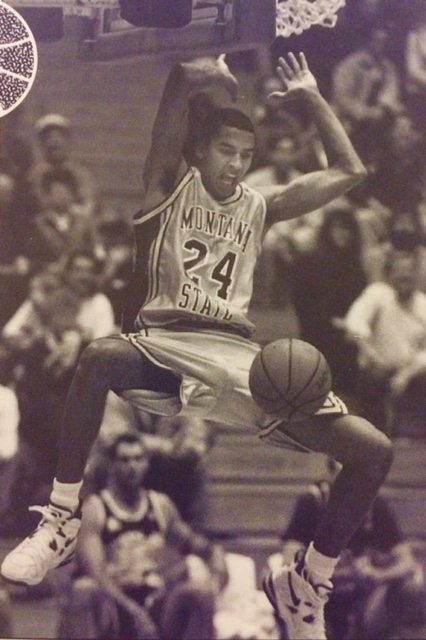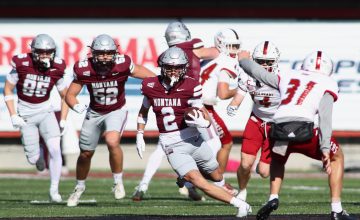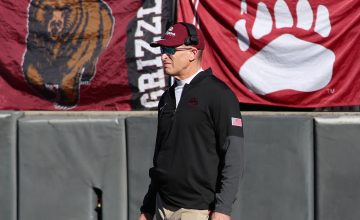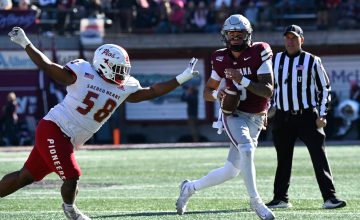It’s been nearly a generation since Montana State’s last trip to the Big Dance to face the intimidating Orange. To Mick Durham, the memories are still crystal clear.
“You remember your championship teams most vividly,” said Durham, Montana State’s head men’s basketball coach for 16 seasons ending in 2006. “It’s just interesting how that works. When you have championship teams, you have character guys, guys who get along and you will never forget them.”
These days, the 1996 MSU Bobcats are scattered around the country. Durham, who is now the head coach at Division II Alaska Fairbanks, runs into Quadre Lollis, Nico Harrison and Danny Sprinkle at the Final Four most years. He keeps track of most of the other players from that special team 19 years ago, one of the best basketball teams produced at Montana State.
Those Bobcats shook off an 8-5 start to blaze through the Big Sky Conference and earn the right to host the league postseason tournament in the last season Idaho and Boise State would be Big Sky members. The Bobcats, who went 16-1 at home that season, won the conference tournament on their home court behind a dazzling performance from Sprinkle, at the time a true freshman.
The Bobcats received a challenging reward. MSU earned a 13-seed in the NCAA Tournament and traveled to Albuquerque to face Syracuse. Almost two decades later, Montana State is still searching for another trip to the Big Dance. On Tuesday, the Bobcats will experience a sort of blast from the past as MSU takes on the Syracuse Orange for the first time since that NCAA Tournament loss.
The non-conference game will be the final stop on MSU’s four-game, 11-day, 5,000-mile road trip. The Bobcats have lost three of four and sit at 5-6 overall. MSU has played just twice in Bozeman in Brian Fish’s second season, a brutal stretch that ends with a trip to the 36,000-seat Carrier Dome in up-state New York.
“Sitting in the big scheme of things where we want to build this program is exposure to our players to things that we could face,” Fish said. “There’s a great possibility if you make the NCAA tournament, you are playing in a dome and it’s a different shooting background than in an arena. It’s against a team that you would probably draw in the first round. There’s a bigger plan here beyond just getting a paycheck for playing them.
“It helps in recruiting too. When you can sit down and tell a young man you play UCLA, Kentucky, Syracuse, you can tell them we will expose you to these games, these type of teams. There’s so many areas with which this helps.”
Fish and the current Bobcats are no strangers to big stages in Fish’s second season. MSU played at UCLA’s Pauley Pavilion and at Kentucky’s Rupp Arena last season.
“I don’t know how we will react to the Carrier Dome the first time but I will have a very good understanding of how we will react after that,” Fish said. “That’s good for me to know. It’s not the Kentucky crowd, I can tell you that having been to both places. It is a different thing, a vast area, a lot of people there but they are not on top of you. It’s not a loud environment. Guessing here, but I don’t think it’s a threatening matchup for their fans as far as excitement.”
Entering the winter of 1995, Durham knew his Bobcats had a chance to be special. Scott Hatler returned for his fourth season as MSU’s starting point guard. The Bobcats had the best perimeter defender in the league in Harrison and the best low-post scorer in the Big Sky in Lollis, both seniors. Local product Adam Leachman provided consistency from the wing during his senior season, a campaign capped with a championship just like his Bozeman High career. Freshman Nate Holmstad provided steady scoring off the bench. And Sprinkle was a freshman phenom waiting to be unleashed. Once the Helena product cracked the starting lineup, MSU posted a 16-5 record as the shooting guard shot 43.7 percent from beyond the arc.
Future NBA standout Malik Rose and Drexel came to MSU’s holiday tournament and defeated the Bobcats in the championship game. When the league schedule began, the Bobcats earned a few signature victories and rode the momentum. Behind 23 points and 16 rebounds from Lollis, MSU exploded for a 90-71 win over reigning champion Weber State in front of 6,317 in Bozeman. A week later, Montana State Harrison’s 22 points led MSU to a 72-65 comeback win over Montana in front of 8,208.
Toward the second half of the conference season, Sprinkle came on strong, helping add to an already potent arsenal that would see Harrison earn his third straight All-Big Sky nod and Lollis earn the Big Sky Most Valuable Player. Sprinkle’s breakout rookie year culminated in Big Sky Tournament MVP honors as MSU defeated Idaho 91-66 in the semifinals and Weber State 81-70 behind Sprinkle’s 30 points in the finals to punch its second-ever trip to the Big Dance.
“Getting a 13 seed, we thought it wasn’t too bad a draw and then it’s a Big East team,” Durham said. “We knew they’d pound the boards. And Syracuse, Montana State will find out next week, that zone is brutal. They still play it. At that point, you aren’t very picky about who you play. You are just excited to be in the tourney. The biggest thing was where they are going to send you.”
The destination was The Pit in Albuquerque. Drexel also drew a trip to New Mexico, giving MSU at least a sense of familiarity. When MSU’s first-round game against Syracuse began, the one certainty the Bobcats expected — the Orange’s vaunted 2-3 zone defense — was nowhere to be found. Montana State shot 37 percent from downtown as a team so the Orange played man to man defense for the duration of the first half as MSU entered the locker room down 38-34.
“I heard (Syracuse head coach Jim) Boeheim speak later that year and he said that ‘We played this Montana State team that literally shot 40 percent from 3 and we thought we’d man them.’ And then he said, ‘We had to swallow our ego at halftime and go back to our zone,’” Durham said. “Sure enough, it ended up being a blow out in the second half because we could not get a quality shot off against that zone.”
With Harrison slowed by an ankle injury and Lollis clamped down on because of Syracuse’s length, the Orange turned the second half into a runaway, eventually posting an 88-55 win. NBA first-round draft pick John Wallace finished with 29 points. Lollis still holds the record for field goal percentage in a first round game by hitting 12 of his 13 shots for a team-high 26 points. That season, Lollis led the NCAA in field goal percentage (67.5 percent), becoming the first Bobcat to lead the country in a statistical category.
“Quadre Lollis had a huge game,” Durham said. “That game really showed what he could do. He was really the only one who could get much done.”
Late in the game, a freshman named Donovan McNabb earned some playing time. McNabb would go on to lead the Orange football team to national prominence before embarking on a standout NFL career most notably with the Philadelphia Eagles.
The Orange would keep winning, defeating Drexel 69-58 to advance to the Sweet 16. Syracuse defeated Tubby Smith’s Georgia Bulldogs 83-81 to advance to the Elite 8. The Orange beat Jacques Vaughn, Raef LaFrentz and the Kansas Jayhawks 60-57 to win the West Regional and advance to the Final Four. Wallace scored 21 points and pulled down nine rebounds as Syracuse defeated Eric Dampier and the Mississippi State Bulldogs to advance to the national title game.
Kentucky, a star-studded team that included future first-round draft picks Tony Delk, Antoine Walker, Ron Mercer and Walter McCarty, defeated Syracuse in the national championship despite Wallace’s 29 points and 10 rebounds.
“It made it special, really special. You felt you bad you lost but they kept winning, kept winning,” Durham said. “John Wallace was the main man that year. Watching them go that far made us feel a little better.”
Durham, an MSU Hall of Famer and former Bobcat player (1977-1980) served as an MSU assistant from 1982 until 1990 before taking over for Stu Starner. Durham, a Three Forks native, watched Jack Gillespie growing up and was a big fan of Roger Craft’s teams as a boy. He was an assistant on the 1986 Bobcat team that fell to St. John’s in the first round of the NCAA tournament. Later on, Durham would lead MSU to the 2002 Big Sky title only to lose in the finals of the conference tournament. It’s been nearly 20 years since MSU has returned to the Big Dance. Durham is not sure how the 1996 Bobcats stack up with the rest of those throughout the school’s history. But he still clearly remembers one of his greatest teams.
“It was the last NCAA tourney we’ve had so in that regard, those guys are special,” Durham said. “I hope we have another one pretty soon. That team is in the Hall of Fame. It’s hard for me to compare to the teams before. But those guys were pretty good. I remember them well and I know people around there do too.”
Photos courtesy of Montana State Athletics. All Rights Reserved.


















